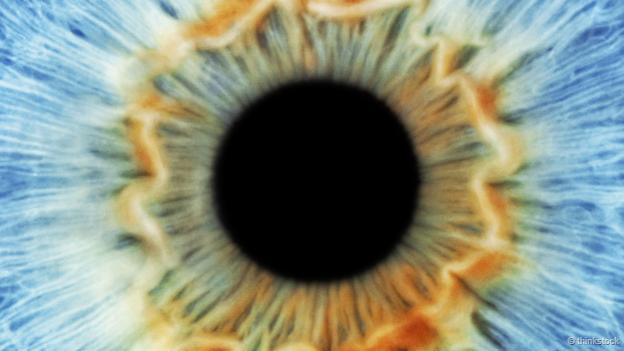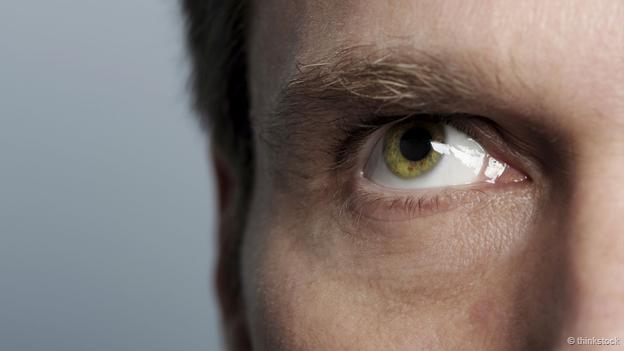你的眼睛是如何透露了你的想法 - BBC莫·科斯坦帝(Mo Costandi)(2023年6月6日)
人们常说,“眼睛是灵魂的窗户”,它可以揭示我们试图隐藏的深层情感。尽管现代科学认为灵魂并不存在,但却证明这句谚语揭示出了一条真理:眼睛不仅能反映大脑活动,还能影响我们的记忆和决策。
“我们并非总能意识到自己的眼球是如何运动的”
眼球时刻都在运动,只不过有些运动并非有意为之,很多都是下意识的。例如,当我们阅读时,眼球就会进入名为“扫视”的高速运动状态,一个接一个地快速注视每个单词。当我们进入一个房间,便会通过更大范围的扫视来环顾四周。而当我们行走时,眼球同样会做出无意识的小幅运动,以抵消头部的晃动,提供稳定的视觉。当然,在睡眠中进入“快速眼动”阶段时,我们的眼球还会左右摆动。

瞳孔扩大表明举棋不定(图片来源:Thinkstock)
目前可以明确的是,某些眼球运动的确能揭示出我们的思考过程。
去年发布的研究表明,瞳孔扩大与决策的不确定程度存在联系:如果某人对自己的决策不太确定,就会感觉兴奋度提升,导致瞳孔扩大。眼睛的这种变化或许也能揭示出决策者的决定:例如,一组研究人员发现,关注瞳孔的扩大程度有可能预测一个经常说“不”的谨慎人士,会在什么时候做出令人难以捉摸的决定,给出“是”的答案。
“如果有人举棋不定,他们的瞳孔就会放大”
观察眼睛甚至有助于预测一个人心里所想的数字。苏黎世大学的托比亚斯·罗切尔(Tobias Loetscher)和他的同事招募了12位志愿者,在其接连说出40个数字的过程中,追踪了他们眼球的运动情况。
结果发现,参与者眼球的运动方向和幅度的确可以预测他们即将说出的数字比前一个数字更大还是更小,甚至连二者的差距都能预测出来。每个志愿者准备说出更大的数字时都会看向右上方,准备说出更小的数字时则会看向左下方。从一侧向另一侧变化的幅度越大,与前一个数字的差距就越大。

我心里想的是什么数字?(图片来源:Thinkstock)

……是个大数,因为我在看向右上方(图片来源:Thinkstock)
这表明我们会以某种方式将脑海里呈现的抽象数字与空间移动联系起来。但该研究并未揭示出二者的先后顺序:是因为想到了特定数字导致眼球位置发生变化,还是因为眼球位置的变化影响了我们的心理活动?2013年,瑞典的研究人员发布的一项证据表明,后者或许更符合实际情况:眼球的运动或许可以促进记忆检索。
“随意转动眼球?这或许对你的记忆有帮助”
他们招募了24名学生,要求每个人都仔细观察通过电脑屏幕的一角展示的一系列物体。参与者之后要听取一系列与其中部分物体有关的描述,例如“那辆车朝向左边”,然后迅速判断这条描述是否正确。研究人员允许其中一些人随意调整自己的目光,其他人则只能看向某个固定的位置,例如屏幕中心的一个十字架,或者刚刚用来展示物体的屏幕一角。
结果发现,可以在回忆过程中随意转动眼球的参与者,表现远好于只能盯住十字架的参与者。但有趣的是,始终盯住用来展示物体的屏幕一角的参与者,表现也好于只能盯住另外一角的参与者。这说明,参与者在信息编码和信息检索这两个过程中的眼球运动越相符,就越能回忆起之前看到的物体。这或许是因为,眼球运动可以帮助我们回忆编码时的物体与周围环境之间的空间关系。

某些眼球运动有助于检索记忆。(图片来源:Thinkstock)
这些眼球运动可能是无意识的。“当人们看到之前见过的场景时,眼睛往往会被其原先看到的信息所吸引,即使他们对此并没有形成自觉的记忆。”负责领导这项研究的隆德大学心理学家罗杰·约翰逊(Roger Johansson)说。
视觉控制
观察眼球运动还可以用于推动人们的决策。最近的一项研究表明,可以利用眼球追踪技术来影响人们的伦理决策——但这或许令人颇感担忧。
研究人员首先向参与者提出一个复杂的道德问题,例如“谋杀是否也有正当理由?”然后在电脑屏幕上展示了候选答案(“有时有”或“永远没有”)。研究人员发现,通过追踪参与者的眼球运动,然后在其盯住其中一个答案看了一段时间后,立刻移除这两个答案,便可促使此人将其刚刚盯住的那个选项作为自己的答案。
“熟练的销售员能够利用眼球运动影响你的购买决策”
“我们不会给他们提供更多信息。”伦敦大学学院神经系统学家、此项研究的高级作者丹尼尔·理查森(Daniel Richardson)说,“我们只是等待他们自己的决策过程逐步展开,然后在合适的时刻打断他们。我们只要控制决策的时间,就能改变他们的想法。”
理查森还补充说,成功的销售员可能已经对此有所了解,并且能够利用这种现象来说服用户。“我们认为有说服力的人是健谈的人,但他们或许也在观察决策过程。”他说,“优秀的销售员或许可以在你犹豫不决地转向某个选择时,为你提供折扣或改变他们的音调。”
随着智能手机和其他手持设备的不断普及,各种眼球追踪应用也变得无处不在,这便增加了远程改变人们决策流程的可能。“如果你在网上购物,他们或许可以在你把目光转向某件商品时提供免费送货。”

不用扫描也能了解内心想法(图片来源:Thinkstock)
因此,眼球运动既可以反映和影响较高层次的心智功能(例如记忆和决策),也可以出卖你的想法、信念和意愿。我们既可以借此改善自己的心智功能,但也有可能因此受到他人的微妙操纵。
“眼睛就像一扇通向思维过程的窗户,但我们却不希望通过这扇窗户泄露过多的信息。”理查森说,“这有可能暴露出某个人希望压制的想法,例如隐含的种族偏见。”
“我可以想象某些用途。例如,可以利用眼球追踪应用来提供辅助性技术,判断你需要哪项手机功能,然后提供帮助。”他补充道,“但如果随时都能用这种技术来追踪各种想法,便可提供更加丰富的信息,有可能会在不知不觉中把我们的想法告诉别人。”
How the eyes betray your thoughts - By Mo Costandi
It’s sometimes said that the eyes are windows into the soul, revealing deep emotions that we might otherwise want to hide. Although modern science precludes the existence of the soul, it does suggest that there is a kernel of truth in this old saying: it turns out the eyes not only reflect what is happening in the brain but may also influence how we remember things and make decisions.
Our eyes are constantly moving, and while some of those movements are under conscious control, many of them occur subconsciously. When we read, for instance, we make a series of very quick eye movements called saccades that fixate rapidly on one word after another. When we enter a room, we make larger sweeping saccades as we gaze around. Then there are the small, involuntary eye movements we make as we walk, to compensate for the movement of our head and stabilise our view of the world. And, of course, our eyes dart around during the ‘rapid eye movement’ (REM) phase of sleep.
Research published last year shows that pupil dilation is linked to the degree of uncertainty during decision-making: if somebody is less sure about their decision, they feel heightened arousal, which causes the pupils to dilate. This change in the eye may also reveal what a decision-maker is about to say: one group of researchers, for example, found that watching for dilation made it possible to predict when a cautious person used to saying ‘no’ was about to make the tricky decision to say ‘yes’.
Watching the eyes can even help predict what number a person has in mind. Tobias Loetscher and his colleagues at the University of Zurich recruited 12 volunteers and tracked their eye movements while they reeled off a list of 40 numbers.
They found that the direction and size of the participants’ eye movements accurately predicted whether the number they were about to say was bigger or smaller than the previous one – and by how much. Each volunteer’s gaze shifted up and to the right just before they said a bigger number, and down and to the left before a smaller one. The bigger the shift from one side to the other, the bigger the difference between the numbers.
This suggests that we somehow link abstract number representations in the brain with movement in space. But the study does not tell us which comes first: whether thinking of a particular number causes changes in eye position, or whether the eye position influences our mental activity. In 2013, researchers in Sweden published evidence that it’s the latter that may be at work: eye movements may actually facilitate memory retrieval.
They recruited 24 students and asked each one to carefully examine a series of objects displayed to them in one corner of a computer screen. The participants were then told to listen to a series of statements about some of the objects they had seen, such as “The car was facing to the left” and asked to indicate as quickly as possible if each was true or false. Some participants were allowed to let their eyes roam about freely; others were asked to fix their gaze on a cross at the centre of the screen, or the corner where the object had appeared, for example.
The researchers found that those who were allowed to move their eyes spontaneously during recall performed significantly better than those who fixed on the cross. Interestingly, though, participants who were told to fix their gaze in the corner of the screen in which objects had appeared earlier performed better than those told to fix their gaze in another corner. This suggests that the more closely the participants’ eye movements during information encoding corresponded with those that occurred during retrieval of the information, the better they were at remembering the objects. Perhaps that’s because eye movements help us to recall the spatial relationships between objects in the environment at the time of encoding.
These eye movements can occur unconsciously. “When people are looking at scenes they have encountered before, their eyes are frequently drawn to information they have already seen, even when they have no conscious memory of it,” says Roger Johansson, a psychologist at Lund University who led the study.
Vision control
Watching eye movements can also be used to nudge people’s decisions. One recent study showed – maybe worryingly – that eye-tracking can be exploited to influence the moral decisions we take.
Researchers asked participants complex moral questions such as “Can murder ever be justified?” and then displayed, on a computer screen, alternative answers (“sometimes justifiable” or “never justifiable”). By tracking the participants’ eye movements, and removing the two answer options immediately after a participant had spent a certain amount of time gazing at one of the two options, the researchers found that they could nudge the participants to provide that particular option as their answer.
“We didn’t give them any more information,” says neuroscientist Daniel Richardson of University College London, senior author of study. “We simply waited for their own decision-making processes to unfold and interrupted them at exactly the right point. We made them change their minds just by controlling when they made the decision.”
Richardson adds that successful salespeople may have some insight into this, and use it to be more persuasive with clients. “We think of persuasive people as good talkers, but maybe they’re also observing the decision-making process,” he says. “Maybe good salespeople can spot the exact moment you’re wavering towards a certain choice, and then offer you a discount or change their pitch.”
The ubiquity of eye-tracking apps for smartphones and other hand-held devices raises the possibility of altering people’s decision-making process remotely. “If you’re shopping online, they might bias your decision by offering free shipping at the moment you shift your gaze to a particular product.”
Thus, eye movements can both reflect and influence higher mental functions such as memory and decision-making, and betray our thoughts, beliefs, and desires. This knowledge may give us ways of improving our mental functions – but it also leaves us vulnerable to subtle manipulation by other people.
“The eyes are like a window into our thought processes, and we just don’t appreciate how much information might be leaking out of them,” says Richardson. “They could potentially reveal things that a person might want to suppress, such as implicit racial bias.”
“I can see eye-tracking apps being used for, say, supportive technologies that figure out what phone function you need and then help out,” he adds, “but if they’re left on all the time they could be used to track all sorts of other things. This would provide much richer information, and raises the possibility of unwittingly sharing our thoughts with others.”